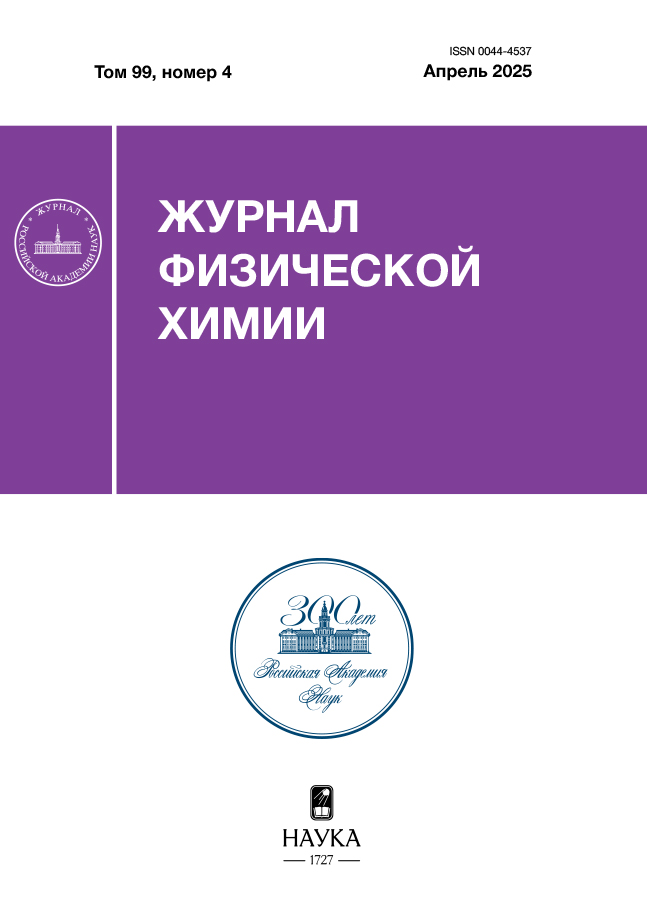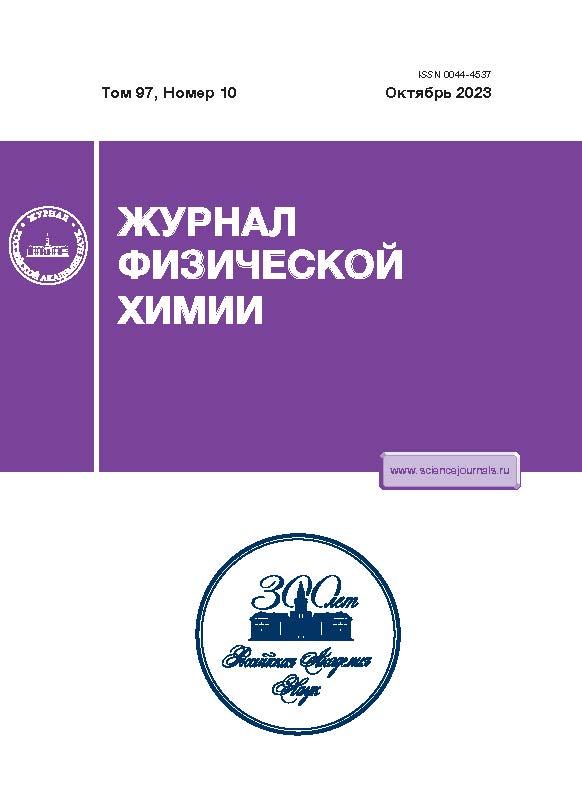Синтез графдинов, исследование их морфологии и сравнительный анализ водород-адсорбционных свойств графенов и графдинов
- Авторы: Солдатов А.П.1, Будняк А.Д.1, Кириченко А.Н.2, Илолов А.М.1
-
Учреждения:
- Институт нефтехимического синтеза им. А.В. Топчиева Российской академии наук
- Частное учреждение Государственной корпорации по атомной энергии “Росатом” “Проектный центр ИТЭР”
- Выпуск: Том 97, № 10 (2023)
- Страницы: 1457-1463
- Раздел: ФИЗИЧЕСКАЯ ХИМИЯ НАНОКЛАСТЕРОВ, СУПРАМОЛЕКУЛЯРНЫХ СТРУКТУР И НАНОМАТЕРИАЛОВ
- Статья получена: 26.02.2025
- Статья опубликована: 01.10.2023
- URL: https://permmedjournal.ru/0044-4537/article/view/668643
- DOI: https://doi.org/10.31857/S0044453723100229
- EDN: https://elibrary.ru/PNXVFH
- ID: 668643
Цитировать
Аннотация
Графдины (ГД) являются двухмерной углеродной наноструктурой, содержащей атомы углерода с sp- и sp2-гибридизацией, причем sp-гибридизированные атомы образуют сопряженные связи, входящие в состав линейных цепей, соединяющих 6-членные углеродные циклы. Результаты сканирующей и просвечивающей электронной микроскопии (СЭМ и ПЭМ), рентгеновской фотоэлектронной) спектроскопии (РФЭС) и рамановской спектроскопии показали, что ГД имеют однородную поверхность и содержат сопряженные –С≡С–С≡С-связи. Исследована водород-адсорбционная способность ГД и проведен сравнительный анализ адсорбции водорода в ГД, графенах, графеновых нанотрубках и графеновых структурах, сформированных на цеолитах. Показано существенное влияние подложки, на которой формируется углеродная наноструктура, на ее адсорбционную способность. Рассмотрена возможность и перспективность синтеза графенов на катализаторах для повышения их эффективности в процессах гидрирования.
Об авторах
А. П. Солдатов
Институт нефтехимического синтеза им. А.В. Топчиева Российской академии наук
Email: Soldatov@ips.ac.ru
Россия, Москва
А. Д. Будняк
Институт нефтехимического синтеза им. А.В. Топчиева Российской академии наук
Email: Soldatov@ips.ac.ru
Россия, Москва
А. Н. Кириченко
Частное учреждение Государственной корпорации по атомной энергии “Росатом”“Проектный центр ИТЭР”
Email: Soldatov@ips.ac.ru
Россия, Москва
А. М. Илолов
Институт нефтехимического синтеза им. А.В. Топчиева Российской академии наук
Автор, ответственный за переписку.
Email: Soldatov@ips.ac.ru
Россия, Москва
Список литературы
- Balaban A.T., Rentia C.C., Ciupitu E. // Rev. Roum. Chim. 1968. V. 13. P. 231.
- Baughman R., Eckhardt H., Kertesz M. // J. Chem. Phys. 1987. V. 87. № 11. P. 6687.
- Ivanovskii A.L. // Prog. Solid State Chem. 2013. V. 41. № 1. P. 1.
- Wan W.B., Brand S.C., Pak J.J. et al. // Chem. A Eur. J. 2000. V. 6. № 11. P. 2044.
- Li G.X., Li Y.L., Liu H.B. et al. // Chem. Commun. 2010. V. 46. P. 3.
- Li G., Li Y., Qian X. et al. // J. Phys. Chem. C. 2011. V. 115. P. 2611.
- Zhou J., Gao X., Liu R. et al. // J. Am. Chem. Soc. 2015. V. 137. № 24. P. 7596.
- Yang N., Liu Y., Wen H. et al. // Nano. 2013. V. 7. № 2. P. 1504.
- Huang C., Zhang S., Liu H. et al. // Nano Energy. 2015. V. 11. P. 481.
- Kuang C., Tang G., Jiu T. et al. // Nano Lett. 2015. V. 15. № 4. P. 2756.
- Gao X., Zhou J., Du R. et al. // Adv. Mater. 2015. https://doi.org/10.1002/adma.201504407
- Li J., Xu J., Xie Z. et al. // Adv. Mater. 2018. V. 30. P. 1800548.
- Si H-Y., Mao C-J., Zhou J-Y. et al. // Carbon. 2018. V. 132. P. 598.
- Yao Y., Jin Z., Chen Y. et al. // Ibid. 2018. V. 129. P. 228.
- Shekar S.C., Swath R.S. // Ibid. 2018. V. 126. P. 489.
- Li C., Lu X., Han Y. et al. // Nano Research. 2018. V. 11. № 3. P. 1714.
- Pan Y., Wang Y., Wang L. et al. // Nanoscale. 2015. V. 7. P. 2116.
- Kan X., Ban Y., Wu C. et al. // ACS Appl. Mater. & Interfaces. 2018. V. 10. № 1. P. 53.
- Mortazavi B., Makaremi M., Shahrokhi M. et al. // Carbon. 2018. V. 137. P. 57.
- Dong Y., Zhao Y., Chen Y. et al. // J. of Materials Sci. 2018. V. 53. № 12. P. 8921.
- Huoliang Gu. et al. // J. Am. Chem. Soc. 2021. V. 143. № 23. P. 8679.
- Yuncheng Du. et al. // Acc. Chem. Res. 2020. V. 53. № 2. P. 459.
- Yang Z. et al. // Comput. Mater. Sci. 2019. V. 160. P. 197.
- Zuo Z., Li Y. // Joule. 2019. V. 3. P. 899.
- Hui L., Xue Y., Yu H. et al. // J. Am. Chem. Soc. 2019. V. 141. P. 10677.
- Guo J., Shi R.C., Wang R. et al. // Laser Photonics Rev. 2020. V. 14. P. 1900367.
- Yin C., Li J.Q., Li T.R. et al. // Adv. Funct. Mater. 2020. V. 30. https://doi.org/. 202001396.https://doi.org/10.1002/adfm
- Guo J., Shi R.C., Wang R. et al. // Laser Photonics Rev. 2020. V. 14. P. 1900367.
- Yan H., Yu P., Han G. et al. // Angew. Chem. Int. Ed. Engl. 2019. V. 58. P. 746.
- Zhou J.Y., Xie Z.Q., Liu R. et al. // ACS Appl. Mater. Interfaces. 2019. V. 11. P. 2632.
- Lv J.X., Zhang Z.M. Wang J. et al. // WACS Appl. Mater. Interfaces. 2019. V. 32.
- Zuo Z., Shang H., Chen Y. et al. // Chem. Commun. (Camb.). 2017. V. 53. P. 8074.
- Li R., Sun H., Zhang Ch. et al. // Carbon. 2022. V. 188. P. 25.
- Gao J., Li J., Chen Y. et al. // Nano Energy. 2018. V. 43. P. 192.
- Yang Z., Zhang Y., Guo M. et al. // Comput. Mater. Sci. 2019. V. 160. P. 197.
- Солдатов А.П., Бондаренко Г.Н., Сорокина Е.Ю. // Журн. физ. химии. 2015. Т. 89. № 2. С. 306. [Soldatov A.P., Bondarenko G.N., Sorokina E.Yu. // Russ. J. of Phys. Chem. A. 2015. V. 89. № 2. P. 282.]
- Tuinstra R., Koenig J.L. // J. Chem. Phys. 1970. V. 53. P. 1126.
- Estrade-Szwarckopf H. // Carbon. 2004. V. 42. P. 1713.
- Ferrari A.C., Meyer J.C., Scardaci V. et al. // Phys. Rev. Lett. 2006. V. 97. P. 187401.
- Солдатов А.П. // Журн. физ. химии. 2020. Т. 94. № 4. С. 483. [Soldatov A.P. // Russ. J. of Phys. Chem. A. 2020. V.94. № 4. P. 663.]
- Солдатов А.П., Кириченко А.Н., Татьянин Е.В. // Там же. 2016. Т. 90. № 7. С. 1038.
- Солдатов А.П. // Там же. 2019. Т. 93. № 3. С. 398. [Soldatov A.P. // Ibid. 2019. V. 93. №3. P. 494.]
- Солдатов А.П. // Там же. 2014. Т. 88. № 7–8. С. 1207. [Soldatov A.P. // Ibid. 2014. V. 88. № 8. P. 1388.]
- Солдатов А.П. // Журн. физ. химии. 2017. Т. 91. № 5. С. 897. [Soldatov A.P. // Ibid.2017. V. 91. № 5. P. 931.]
- Токабе И.К. Катализаторы каталитические процессы. М.: Наука, 1993.
Дополнительные файлы














